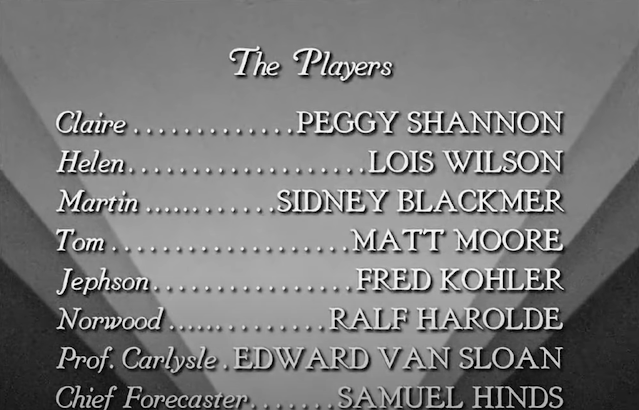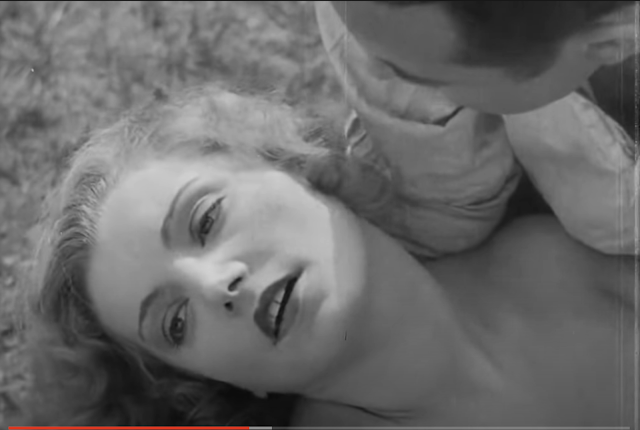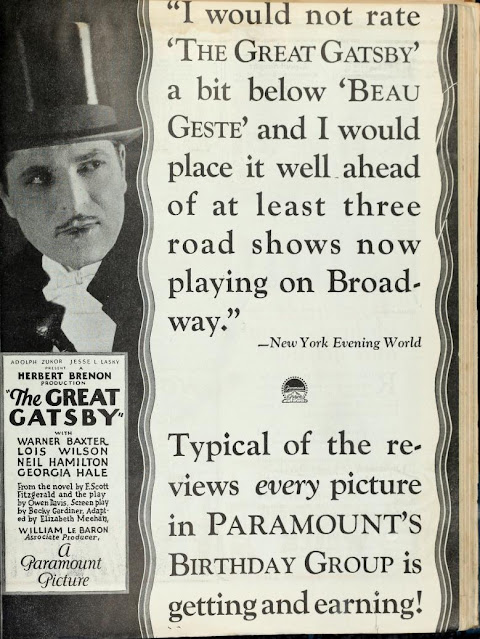I've written a couple of blog posts about Lois Wilson, an actress born in Pittsburgh who grew up in Alabama. She won the first contest of what became the Miss Alabama pageant before heading to Hollywood. Wilson had a long career in both silent and sound films between 1915 and 1949. She also had roles on several television soap operas in the 1950's. Wilson never married and died in 1988.
In the first post I covered her life and career in some detail. In the second one I wrote about Birmingham sculptor George Bridges and the work he created inspired by her 1934 film No Greater Glory.
In one of her 1926 roles she played Daisy Buchanan in the first film version of The Great Gatsby. That film is currently lost; in this post I'm discussing one of her sound films believed lost for many years, the 1933 work Deluge. A copy was discovered in a film archive in Italy in 1981. This Italian-dubbed copy was issued with English subtitles. In 2016 a 35mm negative with an English soundtrack was located and restored by Lobster Films.
Deluge is perhaps the first in a genre familiar to us today--the natural disaster film that focuses on small groups of survivors. We get the buildup as scientists follow the signs of coming events, the disaster itself, and two romances in the ruins. Special effects footage from this film were used in at least three other movies in the 1930's and 1940's.
The film's source is a 1928 novel of the same name by English author S. Fowler Wright. He wrote a number of science fiction novels, as well as historical fiction and mysteries. Deluge: A Romance became a best-seller in both the United States and the United Kingdom. A sequel, Dawn, was published the following year but was not as successful.
Deluge the film was made in what is known as "pre-code Hollywood". This period lasted from the beginning of widespread use of sound in 1929 until mid-1934, when the "Hays Code" of censorship accepted by the studios went into effect. Many films addressed topics later to be banned: infidelity, abortion, illegal drug use, sexual relationships between blacks and whites, promiscuity, prostitution and more. Oh, and what passed at the time for an abundant exposure of female flesh. Most of these films seem tame compared with today's movies and television, but were bold and groundbreaking for sound films in the early 1930's. Deluge manages to include some infidelity and a few glimpses of ladies in their underwear and such.
A lot of the same subjects had been explored in silent films, however. An over the top example is The Mystery of the Leaping Fish, a Sherlock Holmes parody in which Douglas Fairbanks plays Coke Ennyday, who injects you-know-what. The short comedy film is a riotous depiction of cocaine use that seems shocking even now.
All topic drifting aside, I enjoyed watching Deluge. The film holds up remarkably well; the flooding of New York City is especially impressive. Contemporary audiences, not jaded by CGI effects in so many films, could watch in awe as a model Big Apple was swept away. The scene in which the city if totally flooded and most inhabitants drown would be recreated in the 2004 film The Day After Tomorrow. Deluge, which cost $171,000 to make and filmed entirely in Los Angeles, is only 70 minutes long and moves quickly. You can watch Deluge on YouTube.
Wilson made a number of other films after Deluge; her final one was The Girl from Jones Beach in 1949. In the early 1950's she appeared in three different television soap operas. She never married and died at age 93 in 1988.
Actress Peggy Shannon, who plays Claire, died in 1941 at the age of 34. In May of that year her husband Albert Roberts returned to their apartment to find Peggy dead in a chair at the kitchen table. She had died of a heart attacked resulting from alcoholism. Three weeks later Albert committed suicide sitting in the same chair.
The cover of Wright's 1928 novel
Just before the apocalyptic events reach them, there is a touching family scene with Helen [Lois Wilson], Martin and their two children. They soon have to evacuate their home for higher ground.
Some four minutes of the film are devoted to the destruction of New York City.
After the deluge, Martin awakens in a devastated landscape. Helen and the children are nowhere to be found.
Helen is rescued by two lowlifes who do no have the best intentions toward her. We get another bit of Pre-Code female flesh in this scene. At this point we have no idea what's happened to the children.
The two men soon fight over Helen, and the big one, Jephson, survives. In order to escape, Helen heads to the water and swims off.
Pre-Code films got away with this sort of thing.
Meanwhile, Martin has found a cabin and nearby mineshaft to live in. Guess who washes up on his beach--Claire, of course.
Claire and Tom quickly develop feelings for each other in this almost-bucolic Adam-and-Eve situation.
Meanwhile, in the ruins of a seaside town, Helen is reunited with her children and living with a man named Tom.
Some of the men with Jephson have entered the cavern to search for Claire and Martin.
Claire and Martin are ready for them.
Some townspeople happen to be in the area and rescue the pair. The group returns to town, and Martin and Helen are reunited.
Needless to say, Claire and Tom are devastated by this development.
Helen visits Claire and they discuss their mutual love, Martin. Claire is determined not to give him up.




































.jpg)


